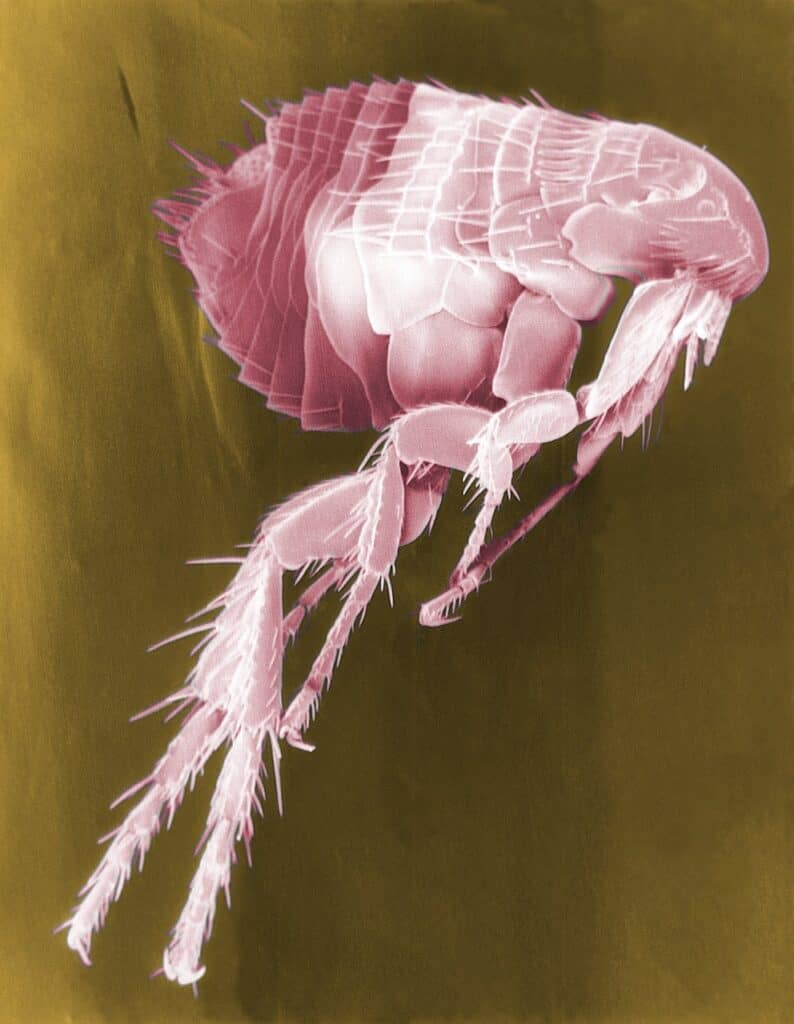Do you want to know about Hedgehog pet fleas?
When I went to vaccinate my hedgehog with a Veterinary Doctor, a couple brought their hedgehog pet for examination, moaning angrily about the fleas their creature had. They were very depressed. The appropriate therapy was administered with the assistance of the Vet Doctor, and I’d want to tell you how to proceed if you find yourself in a similar scenario. I’d want you to read my essay on Types of Hedgehogs, which will enlighten you on the finest forms of tamed hedgehogs to choose as pets.
Here we go,
What Are Fleas, And How Might They Infect My Hedgehog Pet?
Fleas are parasites that feed on blood and tend to cling to the body of the animals to be transported to more suitable places for reproduction and egg laying. In general, these parasites have a tapering form and are somewhat flattened on the sides, with a brown hue in its harshest colors. They have no wings and their flights are enormous jumps propelled by extremely powerful legs that allow them to move with excellent agility. Fleas are attracted to our pets by their environment. If the temperature and humidity parameters are met, the flea can live for up to 12 months. A couple of fleas can multiply to 5 under good conditions.
Where Do Hedgehog Pets Fleas Live
Fleas reside in the cracks and crevices in the floor, the gaps between the walls and the floor, on the carpet, and under the baseboards. Fleas focus on bedding, sleeping baskets, and furniture when there are animals in the room. Adults rely only on domestic animals as a source of sustenance.
The main host of the hedgehog flea is the hedgehog. In addition, other mammals such as dogs, cats, or humans are also affected
Fleas may be found in a variety of locations depending on their developmental stage which is:
The eggs are placed directly in the hair of the animals and fall over carpets/upholstery/furniture/floor gaps and fissures in the walls. They go through the stages of growth in these quiet areas, after which they return to animals as adults.
Larvae like tight, difficult-to-reach, dark, and dusty environments that provide them with security during their growth. Flea pupae can only be found on carpets and floors.
Imago spends most of their time hunting furry creatures for nourishment.
How Do I know if My Hedgehog Pet Has Fleas
Fleas can appear in hedgehogs of any age and gender and at first, the symptoms are not noticeable. Fleas will jump on draperies, carpets, furniture, and upholstery. They appear quickly and then vanish. A change in the animal’s behavior is a sign Hedgehogs sensitive to flea bites will scratch, bite, lick, and scratch themselves, losing their quills.
Fleas leave feces of little black and red patches on bedding or in the hedgehog’s hair which are often referred to as flea dirt. The excrement is small and resembles a scattering of black pepper.
After a flea bite, small redness or sores remain on the skin, which occasionally leads to a secondary bacterial infection.
How Do You Get Rid Of Hedgehog Fleas
Before starting flea treatment, the source of the infestation must first be determined. Various contact insecticides are sprayed onto the surfaces inhabited by the fleas. Your pet’s favorite places such as armchairs, sofas, baskets, or favorite blankets are particularly affected and should be thoroughly vacuumed or washed. To ensure successful control, it is generally recommended to repeat the treatment with contact insecticides after one to two weeks
For the home environment to become flea-free again, taking action against the adult fleas that live on the animal is usually not enough. These make up only about 5 percent of the total flea population. The other 95 percent are made up of eggs, larvae, and pupae and are found in the vicinity of the infested pet and action should be taken
All animals in a household should be treated with appropriate insecticides to rid pets of pests and so prevent fleas from biting people.
It is vital to inspect all of the most frequent places where fleas hide: this includes dark and damp areas such as small gaps in the walls, pantries, and the region beneath the sink where we prefer to accumulate waste. In reality, a considerable amount of organic waste is concentrated here, and the larvae feed on it. As a result, disinfecting all of these areas with water and alcohol (or vinegar) is an excellent idea, another way is to grease the needles of your hedgehog pet with oil.
What Flea Treatment Is Best For Hedgehog Pet
The flea bite does not cause pain, but it is extremely irritating. Its risk, however, resides in the germs it is capable of carrying, and receiving one or more of them demands immediate care. To avoid spreading infections, avoid scratching as much as possible: irritation usually subsides after a few hours and can be alleviated with an ice pack applied to the afflicted region. However, if you develop wheals or tiny blisters as a result of the bite, you should go to your doctor and bring the lesion to his attention: he will then be the one to prescribe specific anti-inflammatory ointments for bug bites or to treat allergic responses that occur as a result of the bite.
The most effective strategy to avoid flea infestations is to use flea prevention on your pet regularly. Make sure to look into a variety of solutions to help protect your pet from fleas; after all, routine illness prevention is far less of a headache than attempting to manage fleas in your home.
Steps In Removing Hedgehog Pet Fleas
- Take Care Of Your Pet and Other Animals in the House: Even if you have only spotted fleas on one of your pets, your other pets probably have them as well. Maintain a regular treatment and preventive regimen for each animal to aid in the prevention of infection and the reduction of the risk of reinfection in the future
- Wash Your Pet’s Bedding In Hot Water: Hot water will aid in the removal of any leftover eggs or larvae. This is a critical stage in flea control. For three to eight weeks, wash bedding at least once a week. They should be dried outside in direct sunshine. If your pet prefers to sleep elsewhere, such as in your bed, you should wash it as well.
- Vacuum The Floor, Carpets, Runners, And Sofas On A Frequent And Thorough Basis: Remember to clean your vacuum cleaner and dispose of the garbage after each use to avoid flea eggs from hatching within and causing additional infestations. Keep vacuuming regularly; at least once every two days for three to eight weeks, to help get rid of fleas in the house swiftly.
- Throughout Your Home, Use A Veterinarian-Approved Flea Spray Or Flea Spray: Make sure to follow the directions and treat your pet’s favorite locations with care. While cleaning your home, read the directions to protect your dogs safe from potentially toxic chemicals. A flea in its pupae stage (before it matures into an adult) is famously difficult to remove. To boost pupae growth into adult fleas that are negatively impacted by chemicals, you must vacuum thoroughly before applying any pesticides.
- Don’t Forget to Treat the Fleas ‘Favorite Hiding Locations: Fleas prefer to hide in automobiles, floor cracks, and behind and under furniture, but they are generally overlooked. Remember to vacuum any fabric surfaces inside your vehicle, and pick pet bedding that can be changed and washed regularly. Vacuum and use flea spray to treat the area behind and under furniture.
- Launder All Your Hedgehog Pets Soft Toys: Flea eggs and larvae can be found in your Hedgehog’s favorite soft toy. If these toys cannot be cleaned, they may have to be discarded.
Another option for removing fleas on your pet is as follows:
- A bowl and a toothbrush are needed
- Fill the bowl with water
- Hold the hedgehog above the water
- Brush the hedgehog several times over the spines with the toothbrush
After the above steps are taken, the fleas fall into the water and drown after a short time
Conclusion
Fleas enter the premises through the clothing or wool of people or pets. They are difficult to identify because of their small size, but their presence may be noticed by their bites, which are highly unpleasant if not treated properly. Most insecticides are useless against fleas, however, drugs containing the active ingredients fipronil, fluvalinate, cypermethrin, and cyfluthrin are. I invite you to read my post How Long Do hedgehog Pet Live, which will enlighten you on the best ways for your pet to live a long life, as well as What Do Hedgehogs Pets Eat And Drink , which provides the greatest to wonderful health for your pet.

